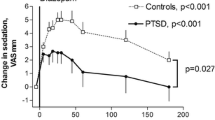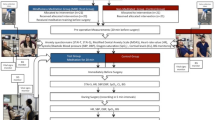Abstract
In a randomised, double-blind, parallel groups study, 40 patients referred for surgical removal of impacted third molars received either (a) temazepam 40 mg orally followed at 35 min by IV saline or (b) oral placebo followed by IV diazepam 10 mg (Diazemuls). Patients were divided into High-Anxious and Low-Anxious groups by median split of their anxiety scores on the Speilberger State Anxiety Scale at the time of oral medication. Compared with placebo, temazepam significantly attenuated anticipatory anxiety in the High-Anxious group while in the Low-Anxious group no difference was found between the treatments. Preoperative but not intraoperative heart-rate distinguished between the High-Anxious and Low-Anxious groups and neither oral temazepam nor IV diazepam abolished the heart-rate response to the traumatic stages of the surgical procedure. The results are interpreted as providing support in a “real life” human stress setting for Gray's neuropsychological model of anxiety.
Similar content being viewed by others
References
Corah NL (1963) Development of a dental anxiety scale. J Dent Res 48:596
Goldstein DS, Dionne R, Sweet J, Gracely R, Brewer B, Gregg R, Keiser HR (1982) Circulatory, plasma catecholamine, cortisol, lipid and psychological responses to a real-life stress (third molar extractions): effects of diazepam sedation and of inclusion of epinephrine with the local anaesthetic. Psychosom Med 44(3):259–272
Gray JA (1975) Elements of a two-process theory of learning. Academic Press London
Gray JA (1981a) The neuropsychology of anxiety: An enquiry into the functions of the septo-hippocampal system. Oxford University Press, Oxford
Gray JA (1981b) Anxiety as a paradigm case of emotion. Br Med Bull 37:193–197
Janke W, Debus G, Longo N (1979) Differential psychopharmacology of tranquilizing and sedating drugs. In: Ban TA et al. (eds) Modern problems in pharmacopsychiatry, vol 14. Karger, Basel, pp 13–98
Kohnen R, Lienert GA (1980) Defining tranquilizers operationally by non additive effect in experimental stress situations. Psychopharmacology 68:291–294
Melamed BG (1979) Behavioural approaches to fear in dental settings. Prog Behav Mod 7:171
O'Boyle CA, Harris D, Barry H (1983) Dental anxiety as a model for assessing anxiolytics: Studies with temazepam. Paper presented to the 14th International CINP Conference, Florence, Italy, June 19–23
Parrott AC (1984) Clobazam, personality stress and performance. Royal Society of Medicine: International Symposium Series (In press)
Parrott AC, Davies S (1983) Effects of a 1,5-benzodiazepine derivative upon performance in an experimental stress situation. Psychopharmacology 79:367–369
Spielberger CD, Gorsuch RL, Lushene RE (1970) Manual for the State-Trait Anxiety Inventory. Consulting Psychologists Press. Palo Alto, California
Author information
Authors and Affiliations
Rights and permissions
About this article
Cite this article
O'Boyle, C.A., Harris, D., Barry, H. et al. Differential effect of benzodiazepine sedation in high and low anxious patients in a “real life” stress setting. Psychopharmacologia 88, 226–229 (1986). https://doi.org/10.1007/BF00652245
Received:
Revised:
Issue Date:
DOI: https://doi.org/10.1007/BF00652245




